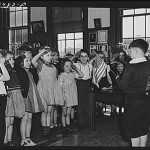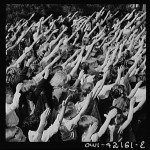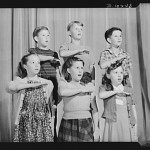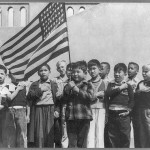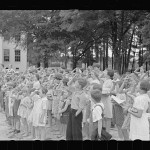WQAD-TV 8, based in Moline, IL, visited Northside School, 520 N. Genesee Street, Morrison, IL, on Friday, September 16, 2016. They featured children in five primary classrooms reciting the Pledge of Allegiance for the camera, at 10:00 a.m. Such filmings are part of the television station’s outreach to communities. At 6:30 a.m., Monday through Friday, they have shown school children from across the viewing area “for three or four years,” stated the cameraman. He said the school will be informed before Northside is featured.
Northside School kindergarten teacher Carissa Swanson signed up “a year ago” for the photo-op and was selected recently. Boys and girls from the three kindergarten rooms participated. One first grade and a second grade classroom were chosen to be included by a drawing.
Kindergarteners (22) from the class of Carissa Swanson:

Kindergarteners (21) from the class of Fran Smith with substitute teacher Charlotte Combs, right, and Classroom Aide Jennifer Eggers:

Kindergarteners (23) from the class of Wendy Connelly, right, with Classroom Aide April Houzenga, left:

First graders (24) taught by Jennie Pruis:

Second graders (17) taught by Susie Ottens:

The History of the Pledge of Allegiance Spellings and punctuation marks are original to the documents.
VERSION 1: James Upham, editor of Youth’s Companion magazine in Boston, MA, first suggested a pledge of allegiance, to celebrate Columbus Day and promote the use of flags in public schools. Under Upham’s supervision, the pledge was written by Francis Bellamy, a Baptist minister and National Socialist leader. President Benjamin Harrison proclaimed it should be used. It appeared in the magazine on September 8, 1892, and was first spoken in public schools on October 12, 1892, in honor of Columbus Day.
I pledge allegiance to my Flag and to the Republic for which it stands: one Nation indivisible, With Liberty and Justice for all.
VERSION 2: The pledge changed 30 years later, on Flag Day, June 14, 1923, with the substitution of these words “the Flag of the United States” instead of “my Flag.” People feared immigrant children would confuse “my” flag with the flag of their homeland.
I pledge allegiance to the Flag of the United States, and to the Republic for which it stands: one Nation indivisible, With Liberty and Justice for all.
VERSION 3: A year later the words “of America” were added; this version was adopted on Flag Day, June 14, 1924. Mexico is officially the United Mexican States.
I pledge allegiance to the Flag of the United States of America, and to the Republic for which it stands: one Nation indivisible, With Liberty and Justice for all.
VERSION 4: Congress amended the pledge 30 years later by adding the words “under God.” The Knights of Columbus had urged the addition of these words. President Dwight Eisenhower signed the bill into law on Flag Day, June 14, 1954.
I pledge allegiance to the Flag of the United States of America, and to the Republic for which it stands: one Nation, under God, indivisible, With Liberty and Justice for all.
The following information appears on the website of The National WW II Museum.
“Although the Pledge of Allegiance was written in 1892 by Francis Bellamy and was recited in schools in the early 20th Century, it wasn’t until June 22, 1942, when the Flag Code became Public Law, that the Pledge of Allegiance was recognized by Congress. The Flag Code addressed all issues regarding treatment of the flag, as well as aspects of ceremony regarding the flag. Still, confusion and controversy surrounded the everyday practice: what did people do, and how did they stand while saying the Pledge of Allegiance?”
“Bellamy had initially conceived of a salute which came to be known as the “Bellamy salute.” This fell out of fashion in the early 1940’s with the rise of Facism and the use of a very similar salute, by the followers of [Adolf] Hitler and [Benito] Mussolini. The Bellamy salute was actually still included in the Flag Code as appropriate decorum. It would not be stricken from the Flag Code until the amendments of December 1942.”
“Images below [are] from the collections of the Library of Congress and the National Archives.” Editor’s note: These are students in American schools.
